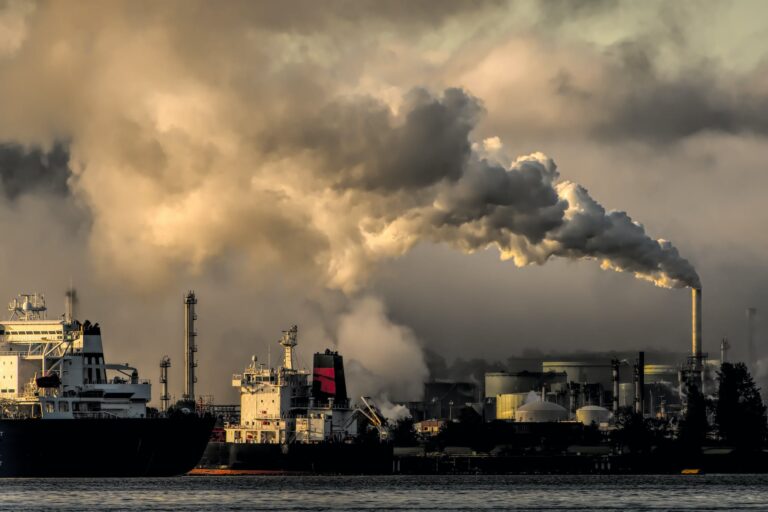On Land and in the Oceans, 2023 Saw Historic climate change Turning Point, Registering Highest Temperatures in Recorded History

In a groundbreaking revelation, 2023 has emerged as the warmest year in the 174-year history of climatic observation, according to a study by The World Meteorological Organization. Up to October, the global mean near-surface temperature soared to approximately 1.40 ± 0.12 °C above the 1850–1900 pre-industrial average. This unprecedented temperature rise has surpassed the previous record-holders, 2016 and 2020, signaling a concerning acceleration in climate change trends.
The past nine years, from 2015 to 2023, have been recorded as the warmest in history. A notable aspect of this warming trend is the record monthly global temperatures observed for the ocean from April to September and the land from July to September. This phenomenon underscores the growing intensity of global warming, affecting both marine and terrestrial ecosystems. Complementing these alarming temperature records, the ten-year average global temperature from 2014–2023 marked the warmest decade on record. This consistent rise in temperatures is closely associated with the increasing concentrations of greenhouse gases. Carbon dioxide, methane, and nitrous oxide levels reached unprecedented highs in 2022, with further increases observed in 2023. The relentless rise of these gases, primarily due to human activities, has been the principal driver of the climatic changes in recent years.
Rising Oceans and Shrinking Ice
The ocean, covering about 70% of the Earth’s surface, has not been spared from these changes. The ocean heat content peaked in 2022, the highest in the 65-year observational record. This increase in oceanic heat content has significant implications, contributing to rising sea levels. In 2023, the global mean sea level reached a new high in the satellite era, reflecting the combined impact of ocean warming and glacier and ice sheet melting.
The Antarctic sea-ice extent in 2023 reached an all-time low for the satellite era, starting in February and continuing with record lows from June onwards. Glaciers in regions like Western North America and the European Alps experienced extreme melt seasons, with glaciers in Switzerland losing around 10% of their volume in the past two years. These melting ice caps and glaciers are not only indicators of rising global temperatures but also contributors to rising sea levels, posing significant threats to coastal regions worldwide.
Extreme Weather Patterns
Extreme weather events of 2023 brought severe socio-economic impacts across the globe. Heatwaves affected vast areas, leading to health emergencies and increased mortality rates. Wildfires raged across regions like Hawaii, Canada, and Europe, resulting in loss of life, destruction of homes, and widespread air pollution. Flooding, particularly severe in Greece, Bulgaria, Turkey, and Libya, caused significant human casualties and highlighted the increasing challenges of food security, population displacement, and the vulnerability of infrastructures to weather and climate hazards.
Socio-economic Ramifications
The climatic changes observed in 2023 have profound implications for sustainable development and progress towards the Sustainable Development Goals (SDGs). For instance, ocean acidity or temperature changes can significantly impact marine life, affecting coastal communities reliant on marine resources. The interconnectedness between climate change and development necessitates synergistic and comprehensive action, especially as the world struggles to meet the targets set by the Paris Agreement.
In summary, the climatic shifts in 2023 represent a critical juncture in our planet’s history, calling for immediate and decisive action to mitigate the effects of climate change. The escalating temperatures, rising sea levels, and increased frequency of extreme weather events emphasize the urgent need for global cooperation and concerted efforts at national and international levels to address this unprecedented global crisis.
Climate Crisis 24/7 used generative AI technology to help produce this article, which a human editor at Climate Crisis 24/7 edited. Climate Crisis 24/7 is dedicated to accuracy and transparency; any article that uses AI will be noted.
Note: This study summarized above is called “The World Meteorological Organization Provisional State of the Global Climate 2023.” You can find a link to the study here: https://wmo.int/sites/default/files/2023-11/WMO%20Provisional%20State%20of%20the%20Global%20Climate%202023.pdf
The individuals and institutions that contributed to this study included:
Individual contributors: Vicente Anzellini (IDMC), Chris Atkinson (Met Office), Omar Baddour (WMO), Paul M Barker (University of New South Wales), Jorge Alvar-Beltrán (FAO), Jana Birner (UNHCR), Nicholas Bishop (IOM), Jessica Blunden (NOAA), Tim Boyer (NOAA NCEI), Anny Cazanave (Legos), Xuan Che (UNDRR), Lijing Cheng (Instute of Atmospheric Physics (IAP), Center for Ocean Mega-Science), John Church (University of New South Wales), Damien Desbruyeres (Ifremer), Caa Domingues (NOC), Robert Dunn (Met Office), Arianna Gialle (FAO), Pini Giancarlo (WFP), Donata Giglio (University of Colorado), John E Gilson (SCRIPPS), Alashiya Gordes (FAO), Atsushi Goto (WMO), Flora Gues (CELAD, Mercator Ocean International), Peer Hechler (WMO), Christopher Hewit (WMO), Shigeki Hosoda (JAMSTEC), Mathias Huss (ETH Zürich), Amanda Ignaa (UNHCR), Kirsten Isensee (IOC/UNESCO), Gregory C Johnson (NOAA PMEL), Christopher Kadow (DKRZ), Hideki Kanamaru (FAO), Maarten Kappelle (UNEP), John Kennedy (WMO Expert), Rachel Killick (Met Office), Brian King (NOC), Nicolas Kolodziejczyk (University of Brest), Animesh Kumar (UNDRR), Mikael Kuusela (Carnegie Mellon University), Gernot Laganda (WFP), Lancelot Leclercq (Legos), Yuehua Li (Yunnan University), Ricardo Locarnini (NOAA NCEI), John Lyman (NOAA PMEL), Shawn Marshall (Environment and Climate Change Canada (ECCC) and University of Calgary), Jesse Mason (WFP), Juta May (UNDRR), Trevor McDougall (University of New South Wales), Brian Menounos (University of Northern British Columbia), Audrey Minère (Mercator Ocean International), Didier Paolo Monselesan (CSIRO), Sarah Purkey (Scripps), James Reagan (NOAA NCEI, University of Maryland), Dean Roemmich (Scripps), Lev Neretin (FAO), Julien Nicolas (ECMWF), Elisabeth Du Parc (IOM), Sylvain Ponserre (IDMC), Ileana Sinziana Puscas (IOM), Claire Ransom (WMO), David Robinson (Rutgers State University of New Jersey), Bonifacio Rogerio (WFP), Kanako Sato (JAMSTEC), Katsunari Sato (JMA), Abhishek Savita (GEOMAR), Robert W Schlegel (Sorbonne Université, CNRS, Laboratoire d’Océanographie de Villefranche), Katherina Schoo (IOC/UNESCO), Serhat Sensoy (Turkish State Meteorological Service), Fumi Sezaki (JMA), Jose Álvaro Silva (WMO), Mike Sparrow (WMO/WCRP), Johan Stander (WMO), Toshio Suga (Tohoku University, JAMSTEC), Oksana Tarasova (WMO), Caterina Tassone (WMO/GCOS), Blair Trewin (Bureau of Meteorology), Karina von Schuckmann (Mercator Ocean International), Ying Wang (UNEP), Susan E Wjiffels (CSIRO, Woods Hole), Abdel-Lathif Younous (WFP), Markus Ziese (DWD, GPCC)
Institutions: Bureau of Meteorology, Australia; Carnegie Mellon University, USA; Center for Ocean Mega-Science, Chinese Academy of Sciences, China; CELAD, France; Commonwealth Scientific and Industrial Research Organization, CSIRO Oceans and Atmosphere, Tasmania, Australia; Deutsches Klimarechenzentrum, DKRZ, Germany; Deutshce Weterdienst, DWD, Germany; European Centre for Medium-range Weather Forecasts, ECMWF, UK; Environment and Climate Change Canada, ECCC, Canada; ETH Zürich; GEOMAR Helmholtz Centre for Ocean Research Kiel, Germany; Global Precipitation Climatology Centre, GPCC, Germany; Hong Kong Observatory; Ifremer, France; IAP, Chinese Academy of Sciences, China; International Displacement Monitoring Centre (IDMC); Japan Marine Earth Scient and Technology, JAMSTEC, Japan; Japan Meteorological Agency, JMA, Japan; Laboratoire d’Océanographie de Villefranche, France; Legos, France; Met Office, UK; Mercator Ocean International, France; National Oceanic and Atmospheric Administration (NOAA) National Centres for Environmental Information (NCEI), USA; National Oceanic and Atmospheric Administration (NOAA) Pacific Marine Environmental Laboratory (PMEL), USA; National Oceanography Centre, Southampton, UK ; Ocean Scope, France ; Rutgers State University of New Jersey; Scripps Institution of Oceanography, University of California San Diego, USA; Sorbonne Université, France; Tohoku University, Japan ; Turkish State Meteorological Service, Türkiye; University of Brest, France ; University of Calgary, Canada; University of Colorado, USA; Cooperative Institute for Satellite Earth Systems Studies, University of Maryland, USA ; University of New South Wales, Australia; University of Northern British Columbia; Woods Hole Oceanographic Institution, USA; Yunnan University, China;
More from ClimateCrisis 247
- Wake-Up call? 30 Million People Could Die Each Year From Climate Change, study says
- It took a lot of balls to bring you this story about microplastics Making a home in Men’s testicles
- Microsoft in new Scope 3 bid as AI emissions soar
- For banks, transparency sets the tone






